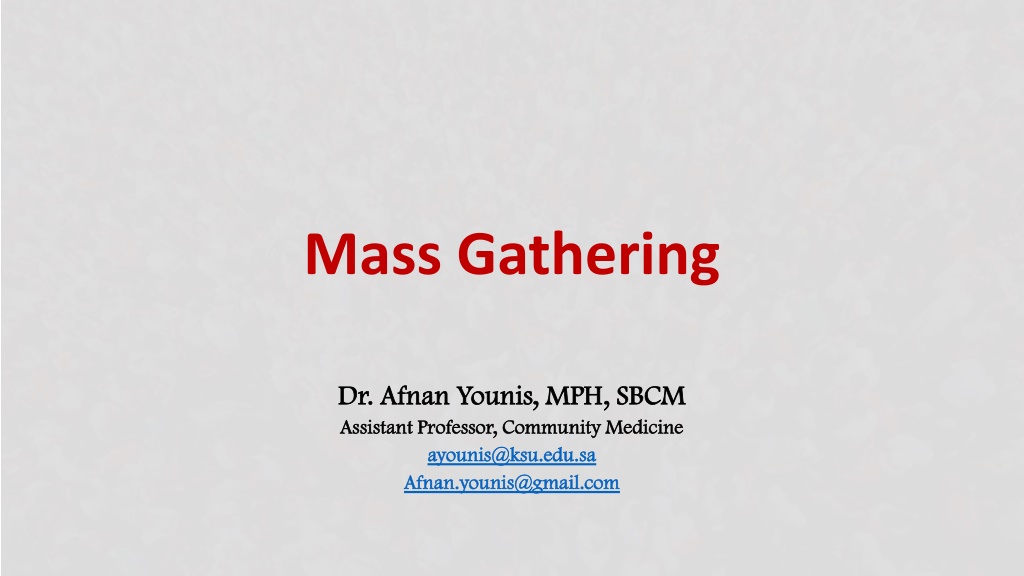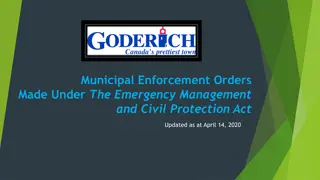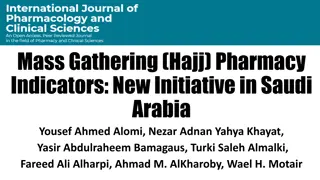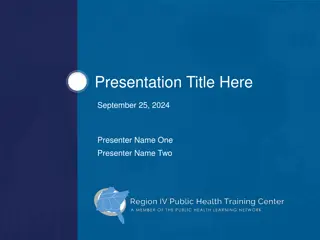Understanding Mass Gatherings and Public Health Risks
Mass gatherings are events that draw large numbers of people together, posing potential public health risks due to factors like population concentration, diverse demographics, and imported diseases. Risk assessment and management play crucial roles in ensuring the safety of participants and the surrounding community.
Download Presentation

Please find below an Image/Link to download the presentation.
The content on the website is provided AS IS for your information and personal use only. It may not be sold, licensed, or shared on other websites without obtaining consent from the author. Download presentation by click this link. If you encounter any issues during the download, it is possible that the publisher has removed the file from their server.
E N D
Presentation Transcript
Mass Gathering Dr. Dr. Afnan Afnan Younis Assistant Professor, Community Medicine Assistant Professor, Community Medicine ayounis@ksu.edu.sa ayounis@ksu.edu.sa Afnan.younis@gmail.com Afnan.younis@gmail.com Younis, MPH, SBCM , MPH, SBCM
Objectives Define mass gathering List MG characteristics that represent public health risk List and understand the steps of MG risk assessment Identify risk based on event assessment Understand the components of risk identification and characterization Understand the components of risk management: surveillance and response
Mass Gathering Mass gatherings (MGs) are events attended by large numbers of individuals, concentrated in a specific area for a specific purpose and over a limited period of time. Number of participants: >1000 persons, although most literature suggests >25000 persons
Categories of MG Planned Recurrent, same location (Hajj) Recurrent, different locations (Olympics) Not recurrent (political speech) Unplanned Unplanned political events Gatherings in natural or man-made disasters, refugees
Types of MG Fairs, exhibitions (World Expo Shanghai) Concerts, festivals (Glastonebury, UK) Sports (Olympics) Religious (Hajj) Political (G8)
MG characteristics that represent public health risk Higher population concentration Diversity of population characteristics Different communities/ parts of the world/ regions Imported diseases Epidemic prone diseases Different health-related behaviors Environmental conditions Heat/ cold Vectors of diseases
MG characteristics that represent public health risk Pressure on infrastructure Hotels Food sales Healthcare system Political attention Terrorism/ bioterrorism
The aim is to: Risk Identification Know the risk, Surveillance Know when it happens, Response Know what to do when it happens
Steps of risk assessment Risk identification (depending on event assessment) Risk characterization (impact, likelihood) Risk management (surveillance and response)
Risk identification Event assessment Risk identification Host country context assessment Systems: need for enhancement in surveillance, testing, reporting, response and command, control and communication Training: responsibilities Population factors: immunity (hosts, visitors) Baseline status for CD
Event assessment: MG features: Type: sports, religious, political, Activity level: seated, standing, mobile Duration: =<24h, 1d-1w, 1m, >1m Occurrence: recurrent, single Environmental factors: Season: summer, winter, wet, dry Participants characteristics: Participants origin: national, international Density of participants: high density Participants health status: elderly, chronically ill, disabled
Event assessment cont. Venue characteristics: Venue: indoor, outdoor, contained, uncontained, rural, temporary, permanent Alcohol and drug use Level of medical services at the venue: 1st aid stations, on-site medical posts, on-site hospitals for participants Catering: professional, informal, self-catering Hygiene/ sanitation services: none, hand washing stations, latrines (permanent, temporary)
Risk identification based on event assessment Event assessment Risk identification Type: Religious event Season: summer International Venue: indoor Venue: temporary Catering: informal Hygiene: hand washing stations Older population with NCD, in-cite medical care Risk of dehydration, heat stroke, Imported diseases Poor air circulation Poor infrastructure Risk of food-born illnesses Decreased risk of infections
Risk characterization Impact on MG, impact on PH (minimal-severe) Risk likelihood
Risk management Implementing measures to reduce the probability or impact of each risk. Based on the risk evaluation Includes: Surveillance programs Response to risks: Special prevention programs (vector control, health education, food safety, water sanitation, hygiene) Medical services Plans for resources should a crisis occur.
MG surveillance Surveillance systems must be sensitive enough to detect potential public health events in a timely manner Depends on: event, existing system, resources Types: active, passive, enhanced, syndromic
Characteristics of a disease for surveillance Outbreak potential Enhanced modes of transmission in the MG (e.g. respiratory spread) Potential use as bioterrorism agents Causes severe illness and require investigation and / or the application of control measures Imported diseases Endemic diseases Highly infectious diseases Needs to be reported under the IHR (2005).
MG Planning Early Multi- sectoral preparation including : event organizers health emergency managers public health authority representatives local hospital emergency departments first-aid personnel Other sectoral partners including police and emergency services. Depends on risk assessment and risk identification
References WHO, 2015. PUBLIC HEALTH FOR MASS GATHERINGS : KEY CONSIDERATIONS.























